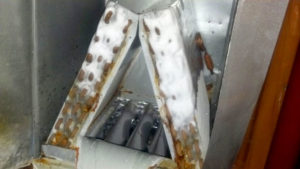Time for a little AC 101 – at least until we get to the meat of this blog.
Your home air conditioning system consists of three main parts: the outside condensing unit, indoor air handler, and the air ducts that deliver cool, fresh air through your vents or registers.
While companies like ours perform countless AC cleanings and inspections each year, our customers have maintenance duties of their own.
One of the most important is cleaning or replacing the AC filter about every two weeks.
 Why is that so important? The more dust, dirt and other particles trapped by the filter – which it’s designed to do – the harder your AC system works to deliver cool air. If a filter is ignored long enough, along with professional annual maintenance, sooner or later your filter will form a considerable obstacle to the cool it’s trying to deliver. And that’s where the frozen coils come into play.
Why is that so important? The more dust, dirt and other particles trapped by the filter – which it’s designed to do – the harder your AC system works to deliver cool air. If a filter is ignored long enough, along with professional annual maintenance, sooner or later your filter will form a considerable obstacle to the cool it’s trying to deliver. And that’s where the frozen coils come into play.
Evaporator coils, located inside the systems’ air handler which, in turn, is typically located in the attic, are designed to absorb heat from indoor air with the help of the refrigerant flowing through them. To perform that task to maximum potential, they count on smooth and abundant airflow. But, as we’ve just seen, there can be proper airflow with a mostly or completely clogged airflow.
When evaporator coils can no longer absorb heat, they’re prone to freeze and, if the problem isn’t detected and fixed early enough, it may force you to replace the air handler, and possibly your condensing unit, too.
So, even if you find your attic a little creepy and an otherwise unpleasant environment, you’ll be doing yourself and your family a big favor by faithfully cleaning or replacing (as needed) your AC filter. While you’re up there, also keep an eye out for any signs of water leakage which would indicate either a refrigerant leak or melting ice you’re your coils.
And, of course, once you see signs of trouble, one quick call to Optimum Air is all it takes to get the problem fixed. Optimum Air in Arlington: for all your home heating and cooling needs.